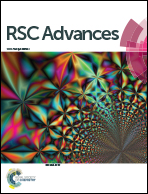Tandem approach for the synthesis of 3-sulfenylimidazo[1,5-a]pyridines from dithioesters†
Abstract
Iodine-mediated synthesis of 3-sulfenylimidazo[1,5-a]pyridines via C–H functionalization has been achieved using dithioesters, 2-methylaminopyridines and sulfonyl hydrazides. A library of 3-sulfanylimidazopyridines and imidazopyridines with broad functionalities are synthesized under metal-free reaction conditions.
![Graphical abstract: Tandem approach for the synthesis of 3-sulfenylimidazo[1,5-a]pyridines from dithioesters](/en/Image/Get?imageInfo.ImageType=GA&imageInfo.ImageIdentifier.ManuscriptID=C6RA03771B&imageInfo.ImageIdentifier.Year=2016)

 Please wait while we load your content...
Please wait while we load your content...